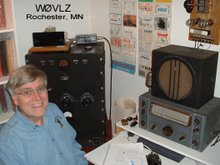After almost a year off the air I'm finally back with a working antenna system.
Before my move I started thinking in terms of a trap vertical at the new QTH but I had safety concerns. My backyard butts up to a public golf course. For many reasons this is a great location but how can I keep a golfer from straying through the yard and, possibly, leaning against my ground mounted vertical as he is searching for a ball? A vertical would not work. I needed something up in the air.
The layout of the yard, safety and the need to keep my installation as unobtrusive as possible led me to an inverted L using insulated wire. I have almost always used some sort of end fed antenna, both for portable/QRP operation and for the main station. An inverted L would be no exception and a 66' wire would easily fit.
I installed my 66' inverted L over a south facing half circle field of 22 40' radials, all terminated at a DX Engineering Radial Plate. This easily loads up on 80 and 30 but presents a very high impedance on 40, 20, 15 and 10 where it is a half wave (or voltage fed) antenna. The solution on these bands is a 49:1 wideband EFHW matching transformer. This allows the high impedance (2.5K-3K) inverted L to be transformed down to 25-100 ohms, a load my transmitter and/or antenna tuner can easily handle.
My shack is just behind the radial plate/hub. I mounted the 49:1 transformer on the inside wall here. I can easily bypass this transformer for operation on 80 and 30. In addition, everything is out of the weather.
Does it work? The Reverse Beacon Network says that my KX3 at 10 watts is covering the US on 40, 30 and 20. On 80 it appears to be working as a NVIS (Near Vertical Incidence Skywave) antenna as expected . I'll find out for certain starting in November as we move into the winter vintage radio contest season.



